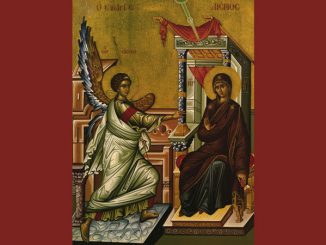
We take the week of Christmas and the following week off from faith formation classes. That means we might have one or two classes during the Christmas season—and those after the world has already moved on past trees and tinsel. How do we teach children the importance of the Christian understanding of Christmas when the timing seems a bit awkward?
I try to do so by using the last class before Christmas as a project day. I acknowledge that we are still in the season of Advent, but since we are fast approaching Christmas, I lead my group in a few projects that will help bridge the seasons. On the schedule:
Christmas Gospels Worksheet—Grade 7, Session 10 of Finding God is a lesson on Advent and Christmas. We covered the Advent section in an earlier session. On project day we will do the worksheet for the chapter, which invites young people to read the stories of Jesus’ birth and identify which elements of the story are found in Matthew or Luke.
Advent Bingo—This allows us a review of the Advent season with a fun game that takes little explanation to understand, since most people know the game of Bingo already. We usually have time for two rounds of the game. For prizes I use stickers or wrapped candy that is not to be opened in the classroom. That way we don’t have to worry about food allergies or cleanup after the game (beyond being sure all the Bingo tokens are picked up). So that no one is left out, before class dismisses I give the non-winners candy too. I hold this Advent activity after the Gospels worksheet to ensure good behavior—young people can get excited about a game and have trouble settling into a Bible lookup activity after it. An easier transition from the game is to a craft project.
“O” Antiphons Wreath—Young people don’t often get exposed to the tradition of the “O” Antiphons. I lead a discussion on what these prayers are, referencing the familiar song, “O Come, O Come, Emmanuel.” I hand out a list of the “O” Antiphons and then invite young people to create a wreath of the symbols associated with these prayers. For the wreath’s circle, we use paper plates, cutting out the center. If there is time, young people can color the plate green, or it can be left white. While the group works, I play a recording of “O Come, O Come, Emmanuel.”
Star Reflection—I’ve shared before how my class responds well to guided meditation. For our prayer time on project day, I lead a reflection that takes as its focus a star that can float over what children might be experiencing during the Christmas season to help them see how God is present.
Christmas Card Gifts—As the final activity on project day, I invite the group to consider what non-material gifts they could give people this Christmas. I provide Christmas cards for young people to write gift promises to loved ones for presentation on the holiday. Students could also be invited to create their own cards, but by providing pre-made cards, I require less time for the activity. Plus, students who are less artistically inclined don’t have to worry about what the card looks like and can focus on the gift promises. I have at least two cards per young person available for this activity.
As the class draws to a close and we do our classroom cleanup, I remind the young people that we are still in the season of Advent, but we will celebrate Christmas as a Church for several weeks, not just on December 25.
How do you celebrate Christmas with your group?





I especially like the O Antiphon wreath idea. You’re right that these antiphons don’t get enough attention. I couldn’t help but think of hockey announcer “Doc” Emrick who shouts “Oh!” whenever someone comes close to scoring…such a natural human expression when on the doorstep of something good!
I never thought of it that way, Joe, but you’re right. I always liked the antiphons to explore “O Come, O Come Emmanuel” and why that was the go-to Advent hymn.
Your ideas are great and on point. I usually begin with a calendar and ask “How long is Christmas?” “When does it begin? When does it end?” Many do not know that ir is a season and ends of January 6th. I also introduce the 12 Days of Christmas song and explain the meaning behind the images like the partridge, the tree an who is “my true love.” Finally, I show Merry Christmas Charlie Brown and focus on Linus’ monologue towards the end.
Thanks, Abraham. Explaining the meanings of the 12 Days of Christmas is a good activity idea.
I have 17 first graders in Faith Formation. We take a ‘field trip’ to see the huge advent wreath in the church, then try to make an even bigger one. By this time, they know the colors, references. With ALL materials purchased at dollar stores, we make a wreath:
3 9′ green garland…several students create a circle with the garland
5 white poster boards
Shiny pink and purple wrapping paper…glue the wrapping paper to poster boards;
Make cylinders out of the poster boards, label with HOPE, JOY, etc….secure with staples The last board remains white for Christ’s candle….
Shiny red cellophane…crumple a large amount of cellophane and stick in the top of each candle to ‘light’ it.
What a fun idea, Shannon! I’m sure that makes an impression on the first graders that helps them learn about the Advent wreath. Thank you for sharing.
For my 2nd graders I also have a series of activities, though I mostly move beyond Advent and focus on the Nativity. The one aspect of Advent I carried through in this week’s class was the visit from our “Advent Angel” (my Catholic version of “The Elf on the Shelf” “Fidelis” appeared in our class weekly during Advent with a notes encouraging the children to pray more and do “Advent Acts of Kindess”. Week 1 s/he left a sort of Advent calendar on Week 1 with AAK suggestions to be colored in as completed. Week 2 Fidelis left everyone a holy card and asked the children to pray the Guardian Angel prayer each day. This week Fidelis left candy canes for a gift and again encouraged AAK to become a habit and prayer. The rest of class I read the Nativity story, we make a candy cane ornament/talk about the symbolism of the candy cane, make Christmas cards for our parish priests (one year to my surprize they were the basis of the entire Christmas homily) and play a ‘left-right’ passing game of the story of the Nativity including the Magi. This introduces the Magi which I focus on in our first class after the holidays.